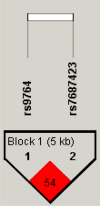Associations Between Neurotransmitter Genes and Fatigue and Energy Levels in Women After Breast Cancer Surgery
- PMID: 27720787
- PMCID: PMC5191954
- DOI: 10.1016/j.jpainsymman.2016.08.004
Associations Between Neurotransmitter Genes and Fatigue and Energy Levels in Women After Breast Cancer Surgery
Abstract
Context: Fatigue is a common problem in oncology patients. Less is known about decrements in energy levels and the mechanisms that underlie both fatigue and energy.
Objectives: In patients with breast cancer, variations in neurotransmitter genes between lower and higher fatigue latent classes and between the higher and lower energy latent classes were evaluated.
Methods: Patients completed assessments before and monthly for six months after surgery. Growth mixture modeling was used to identify distinct latent classes for fatigue severity and energy levels. Thirty candidate genes involved in various aspects of neurotransmission were evaluated.
Results: Eleven single-nucleotide polymorphisms or haplotypes (i.e., ADRB2 rs1042718, BDNF rs6265, COMT rs9332377, CYP3A4 rs4646437, GALR1 rs949060, GCH1 rs3783642, NOS1 rs9658498, NOS1 rs2293052, NPY1R Haplotype A04, SLC6A2 rs17841327, and 5HTTLPR + rs25531 in SLC6A4) were associated with latent class membership for fatigue. Seven single-nucleotide polymorphisms or haplotypes (i.e., NOS1 rs471871, SLC6A1 rs2675163, SLC6A1 Haplotype D01, SLC6A2 rs36027, SLC6A3 rs37022, SLC6A4 rs2020942, and TAC1 rs2072100) were associated with latent class membership for energy. Three of 13 genes (i.e., NOS1, SLC6A2, and SLC6A4) were associated with latent class membership for both fatigue and energy.
Conclusions: Molecular findings support the hypothesis that fatigue and energy are distinct, yet related symptoms. Results suggest that a large number of neurotransmitters play a role in the development and maintenance of fatigue and energy levels in breast cancer patients.
Keywords: Fatigue; breast cancer; candidate genes; energy; growth mixture modeling; neurotransmitter genes.
Copyright © 2016 American Academy of Hospice and Palliative Medicine. Published by Elsevier Inc. All rights reserved.
Figures





Similar articles
-
Polymorphisms in Cytokine Genes Are Associated With Higher Levels of Fatigue and Lower Levels of Energy in Women After Breast Cancer Surgery.J Pain Symptom Manage. 2016 Nov;52(5):695-708.e4. doi: 10.1016/j.jpainsymman.2016.04.014. Epub 2016 Sep 21. J Pain Symptom Manage. 2016. PMID: 27664835 Free PMC article.
-
Associations Between Catecholaminergic and Serotonergic Genes and Persistent Breast Pain Phenotypes After Breast Cancer Surgery.J Pain. 2018 Oct;19(10):1130-1146. doi: 10.1016/j.jpain.2018.04.007. Epub 2018 Apr 30. J Pain. 2018. PMID: 29723560
-
Chronic Decrements in Energy in Women with Breast Cancer are Associated with Cytokine Gene Polymorphisms.Semin Oncol Nurs. 2024 Aug;40(4):151652. doi: 10.1016/j.soncn.2024.151652. Epub 2024 Jun 4. Semin Oncol Nurs. 2024. PMID: 38834449
-
The genetic variants underlying breast cancer treatment-induced chronic and late toxicities: a systematic review.Cancer Treat Rev. 2014 Dec;40(10):1199-214. doi: 10.1016/j.ctrv.2014.10.001. Epub 2014 Oct 14. Cancer Treat Rev. 2014. PMID: 25458605
-
Symptom Science: Advocating for Inclusion of Functional Genetic Polymorphisms.Biol Res Nurs. 2019 Jul;21(4):349-354. doi: 10.1177/1099800419846407. Epub 2019 Apr 25. Biol Res Nurs. 2019. PMID: 31023072 Free PMC article. Review.
Cited by
-
Perceived fatigue and energy are independent unipolar states: Supporting evidence.Med Hypotheses. 2018 Apr;113:46-51. doi: 10.1016/j.mehy.2018.02.014. Epub 2018 Feb 19. Med Hypotheses. 2018. PMID: 29523293 Free PMC article.
-
Qualitative interview study exploring the patient experience of living with axial spondyloarthritis and fatigue: difficult, demanding and draining.BMJ Open. 2022 Feb 25;12(2):e053958. doi: 10.1136/bmjopen-2021-053958. BMJ Open. 2022. PMID: 35217538 Free PMC article.
-
A draft conceptual model of SLC6A1 neurodevelopmental disorder.Front Neurosci. 2023 Jan 19;16:1026065. doi: 10.3389/fnins.2022.1026065. eCollection 2022. Front Neurosci. 2023. PMID: 36741059 Free PMC article.
-
Fear of pain moderates the relationship between self-reported fatigue and methionine allele of catechol-O-methyltransferase gene in patients with fibromyalgia.PLoS One. 2021 Apr 28;16(4):e0250547. doi: 10.1371/journal.pone.0250547. eCollection 2021. PLoS One. 2021. PMID: 33909692 Free PMC article.
-
Distinct attentional function profiles in older adults receiving cancer chemotherapy.Eur J Oncol Nurs. 2018 Oct;36:32-39. doi: 10.1016/j.ejon.2018.08.006. Epub 2018 Aug 22. Eur J Oncol Nurs. 2018. PMID: 30322507 Free PMC article.
References
-
- Prue G, Rankin J, Allen J, Gracey J, Cramp F. Cancer-related fatigue: A critical appraisal. Eur J Cancer. 2006;42:846–863. - PubMed
-
- Siefert ML. Fatigue, pain, and functional status during outpatient chemotherapy. Oncol Nurs Forum. 2010;37:E114–123. - PubMed
-
- Huang HP, Chen ML, Liang J, Miaskowski C. Changes in and predictors of severity of fatigue in women with breast cancer: A longitudinal study. Int J Nurs Stud. 2014;51:582–592. - PubMed
-
- Lerdal A. A theoretical extension of the concept of energy through an empirical study. Scand J Caring Sci. 2002;16:197–206. - PubMed
MeSH terms
Substances
Grants and funding
LinkOut - more resources
Full Text Sources
Other Literature Sources
Medical
Miscellaneous

